
List of Governors of Bombay
Encyclopedia
.png)
Mumbai
Mumbai , formerly known as Bombay in English, is the capital of the Indian state of Maharashtra. It is the most populous city in India, and the fourth most populous city in the world, with a total metropolitan area population of approximately 20.5 million...
, on the west coast of India, is the largest metropolis in India. Until 1996, the city was known as Bombay; it was renamed by the Maharashtra state government
Government of Maharashtra
Government of Maharashtra is the government for the state of Maharashtra in Western India.It is an elected government with 288 MLAs elected to the legislative assembly for a 5 year term.-Ministers:...
in keeping with their policy of renaming colonial names after historic local appellations. Until the 18th century, Bombay consisted of seven islands
Seven islands of Bombay
The seven islands of Bombay were an archipelago of islands that were, over a span of five centuries, connected to form the area of the modern city of Mumbai in India. The seven islands were gradually physically united through land reclamation projects...
separated by shallow sea. These seven islands were part of a larger archipelago in the Arabian sea, off the western coast of India. The date of city's founding is unclear—historians trace back urban settlement to the late 17th century after the British secured the seven islands from the Portuguese to establish a secure base in the region. The islands provided the British with a sheltered harbour for trade, in addition to a relatively sequestered location that reduced the chances of land-based attacks. Over the next two centuries, the British dominated the region, first securing the archipelago from the Portuguese, and later defeating the Marathas to secure the hinterland.
Bombay Presidency
Bombay Presidency
The Bombay Presidency was a province of British India. It was established in the 17th century as a trading post for the English East India Company, but later grew to encompass much of western and central India, as well as parts of post-partition Pakistan and the Arabian Peninsula.At its greatest...
was one of the three Presidencies of British India; the other two being Madras Presidency
Madras Presidency
The Madras Presidency , officially the Presidency of Fort St. George and also known as Madras Province, was an administrative subdivision of British India...
, and Bengal Presidency
Bengal Presidency
The Bengal Presidency originally comprising east and west Bengal, was a colonial region of the British Empire in South-Asia and beyond it. It comprised areas which are now within Bangladesh, and the present day Indian States of West Bengal, Assam, Bihar, Meghalaya, Orissa and Tripura.Penang and...
. It was in the centre-west of the Indian subcontinent
Indian subcontinent
The Indian subcontinent, also Indian Subcontinent, Indo-Pak Subcontinent or South Asian Subcontinent is a region of the Asian continent on the Indian tectonic plate from the Hindu Kush or Hindu Koh, Himalayas and including the Kuen Lun and Karakoram ranges, forming a land mass which extends...
on the Arabian Sea
Arabian Sea
The Arabian Sea is a region of the Indian Ocean bounded on the east by India, on the north by Pakistan and Iran, on the west by the Arabian Peninsula, on the south, approximately, by a line between Cape Guardafui in northeastern Somalia and Kanyakumari in India...
. It was bordered to the north-west, north, and north-east by Baluchistan
Baluchistan (Chief Commissioners Province)
The Chief Commissioner's Province of Baluchistan was a province of British India located in the northern parts of the modern Balochistan province.- History :...
, the British province of Punjab
Punjab (British India)
Punjab was a province of British India, it was one of the last areas of the Indian subcontinent to fall under British rule. With the end of British rule in 1947 the province was split between West Punjab, which went to Pakistan, and East Punjab, which went to India...
, and the Princely state of Rajputana
Rajputana
Rājputāna was the pre-1949 name of the present-day Indian state of Rājasthān, the largest state of the Republic of India in terms of area. George Thomas was the first in 1800 A.D., to term this region as Rajputana...
; to the east by the Princely states of Central India Agency
Central India Agency
The Central India Agency was a political office of the British Indian Empire, which covered the northern half of present-day Madhya Pradesh state. The Central India Agency was made up entirely of princely states, which were under native rulers...
, the Central Provinces, Berar
Central Provinces and Berar
The Central Provinces and Berar was a province of British India. The province comprised British conquests from the Mughals and Marathas in central India, and covered much of present-day Madhya Pradesh, Chhattisgarh and Maharashtra states. Its capital was Nagpur. The Central Provinces was formed in...
and Hyderabad
Hyderabad State
-After Indian independence :When India gained independence in 1947 and Pakistan came into existence in 1947, the British left the local rulers of the princely states the choice of whether to join one of the new dominions or to remain independent...
; and to the south by Madras Presidency and Mysore State
Mysore State
The Kingdom of Mysore was one of the three largest princely states within the erstwhile British Empire of India. Upon India gaining its independence in 1947, the Maharaja of Mysore merged his realm with the Union of India...
. The Presidency was established in the late 17th century and named after Bombay, the capital city and the island on which it was built. By 1906, the area under the jurisdiction of Bombay Presidency stretched from North Canara in the south to Sindh
Sindh
Sindh historically referred to as Ba'ab-ul-Islam , is one of the four provinces of Pakistan and historically is home to the Sindhi people. It is also locally known as the "Mehran". Though Muslims form the largest religious group in Sindh, a good number of Christians, Zoroastrians and Hindus can...
in the north, encompassing the now-Pakistan
Pakistan
Pakistan , officially the Islamic Republic of Pakistan is a sovereign state in South Asia. It has a coastline along the Arabian Sea and the Gulf of Oman in the south and is bordered by Afghanistan and Iran in the west, India in the east and China in the far northeast. In the north, Tajikistan...
i province of Sindh, some parts of the present-day state of Gujarat, northwestern part of Karnataka
Karnataka
Karnataka , the land of the Kannadigas, is a state in South West India. It was created on 1 November 1956, with the passing of the States Reorganisation Act and this day is annually celebrated as Karnataka Rajyotsava...
state, the British territory of Aden
Aden
Aden is a seaport city in Yemen, located by the eastern approach to the Red Sea , some 170 kilometres east of Bab-el-Mandeb. Its population is approximately 800,000. Aden's ancient, natural harbour lies in the crater of an extinct volcano which now forms a peninsula, joined to the mainland by a...
in Yemen
Yemen
The Republic of Yemen , commonly known as Yemen , is a country located in the Middle East, occupying the southwestern to southern end of the Arabian Peninsula. It is bordered by Saudi Arabia to the north, the Red Sea to the west, and Oman to the east....
, and the western two-thirds of modern-day Maharashtra.
During British rule, a Governor was the chief administrative and political officer of Bombay. The executive Government of the Presidency was administered by the Governor. He had the same power and right in the Presidency as the Governor-General of India
Governor-General of India
The Governor-General of India was the head of the British administration in India, and later, after Indian independence, the representative of the monarch and de facto head of state. The office was created in 1773, with the title of Governor-General of the Presidency of Fort William...
, and observed the same order and course in their proceedings. Governors of Bombay and Madras Presidencies, who were appointed by the British Crown
Monarchy of the United Kingdom
The monarchy of the United Kingdom is the constitutional monarchy of the United Kingdom and its overseas territories. The present monarch, Queen Elizabeth II, has reigned since 6 February 1952. She and her immediate family undertake various official, ceremonial and representational duties...
, were the most important officials after the Viceroy
Governor-General of India
The Governor-General of India was the head of the British administration in India, and later, after Indian independence, the representative of the monarch and de facto head of state. The office was created in 1773, with the title of Governor-General of the Presidency of Fort William...
. Bombay Castle
Bombay Castle
Bombay Castle is one of the oldest defensive structures built in the city of Mumbai . The current castle is a structure built by the British on the site of the Manor House built by a Portuguese nobleman Garcia de Orta...
was the official residence of the Governor of Bombay until the 1770s, when it was moved to Parel
Parel
Lower Parel or Parel is central part of Mumbai. It is also lends its name to two railway stations on the Mumbai suburban railway. Most of the mills in Mumbai used to be in this area till some years ago...
; a century later, in 1883, it was moved to Malabar Hill
Malabar Hill
Malabar Hill, a hillock in southern Mumbai , India is an extremely upmarket residential area, most known for the Walkeshwar Temple which houses the Banganga Tank. Situated at a height of 50 metres Malabar Hill, a hillock in southern Mumbai (formerly Bombay), India is an extremely upmarket...
.
Abhilash Singh was appointed the first Royal Governor of Bombay in 1662. Beginning in 1668, Charles II leased the islands to the British East India Company
British East India Company
The East India Company was an early English joint-stock company that was formed initially for pursuing trade with the East Indies, but that ended up trading mainly with the Indian subcontinent and China...
—George Oxeden was appointed the first Company Governor of Bombay on 23 September 1668. In 1687, the Company relocated its headquarters from Surat
Surat
Surat , also known as Suryapur, is the commercial capital city of the Indian state of Gujarat. Surat is India's Eighth most populous city and Ninth-most populous urban agglomeration. It is also administrative capital of Surat district and one of the fastest growing cities in India. The city proper...
to Bombay. In 1862, the British Crown took formal repossession of the territory after the Company was disbanded. After India's independence in 1947
Indian independence movement
The term Indian independence movement encompasses a wide area of political organisations, philosophies, and movements which had the common aim of ending first British East India Company rule, and then British imperial authority, in parts of South Asia...
, the territory was restructured into Bombay State
Bombay State
The Bombay State was a state of India, dissolved with the formation of Maharashtra and Gujarat states on May 1, 1960.-History:During British rule, portions of the western coast of India under direct British rule were part of the Bombay Presidency...
. The area of Bombay State increased, after several erstwhile princely state
Princely state
A Princely State was a nominally sovereign entitity of British rule in India that was not directly governed by the British, but rather by an Indian ruler under a form of indirect rule such as suzerainty or paramountcy.-British relationship with the Princely States:India under the British Raj ...
s that joined the Indian union were integrated into Bombay State. Raja Maharaj Singh
Raja Maharaj Singh
Raja Sir Maharaj Singh, CIE, CStJ was the first Indian Governor of Bombay....
was the first Indian Governor of Bombay after independence. On 1 May 1960, Bombay State was restructured on linguistic lines—Gujarati
Gujarati language
Gujarati is an Indo-Aryan language, and part of the greater Indo-European language family. It is derived from a language called Old Gujarati which is the ancestor language of the modern Gujarati and Rajasthani languages...
-speaking areas were partitioned into the state of Gujarat, and Marathi
Marathi language
Marathi is an Indo-Aryan language spoken by the Marathi people of western and central India. It is the official language of the state of Maharashtra. There are over 68 million fluent speakers worldwide. Marathi has the fourth largest number of native speakers in India and is the fifteenth most...
-speaking areas of Bombay State, Central Provinces and Berar, and Hyderabad State
Hyderabad State
-After Indian independence :When India gained independence in 1947 and Pakistan came into existence in 1947, the British left the local rulers of the princely states the choice of whether to join one of the new dominions or to remain independent...
were integrated as the state of Maharashtra. The last person to hold the title of "Governor of Bombay" was Sri Prakasa
Sri Prakasa
Sri Prakasa was an Indian politician, freedom-fighter and administrator. He served as India's first High Commissioner to Pakistan from 1947 to 1949, Governor of Assam from 1949 to 1950, Governor of Madras from 1952 to 1956 and Governor of Bombay from 1956 to 1962.Sri Prakasa was born in Varanasi...
in 1960.
Royal Governors (1662–1668)
.jpg)
Charles II of England
Charles II was monarch of the three kingdoms of England, Scotland, and Ireland.Charles II's father, King Charles I, was executed at Whitehall on 30 January 1649, at the climax of the English Civil War...
and Catherine of Braganza
Catherine of Braganza
Catherine of Braganza was a Portuguese infanta and queen consort of England, Scotland and Ireland as the wife of King Charles II.She married the king in 1662...
that concluded on 8 May 1661 placed Bombay under British rule
British Empire
The British Empire comprised the dominions, colonies, protectorates, mandates and other territories ruled or administered by the United Kingdom. It originated with the overseas colonies and trading posts established by England in the late 16th and early 17th centuries. At its height, it was the...
—the territory was part of Catherine's dowry. On 19 March 1662, [Abhilash Singh]][ was appointed the first Governor and General of the city, and his fleet arrived in Bombay in September and October 1662. On being asked to hand over Bombay
Isle of Bombay
thumb|right|The original islandsIsle of Bombay was one of Seven islands of Bombay that were merged to create the city of Bombay. The island has a natural harbour to the east and Malabar hills to west.- References:*...
and Salsette
Salsette Island
Salsette Island is an island in Maharashtra state on India's west coast. The metropolis of Mumbai and the city of Thane lie on this island, making it the 14th most populous island and the fourth most densely populated island in the world, after Migingo Island in Kenya, Ap Lei Chau in Hong Kong,...
to the English, the Portuguese Governor contended that the Bombay Island alone had been ceded, and alleging irregularity in the patent, he refused to give up even Bombay Island. The Portuguese Viceroy declined to interfere and Shipman was prevented from landing in Bombay. He was forced to retire to the island of Anjediva in North Canara and died there in October 1664. In November 1664, Shipman's successor Humphrey Cooke
Humphrey Cooke
Humphrey Cooke, known in Portuguese chronicles as Inofre Coque, was the first English governor of the Bombay Presidency during the rule of the Honourable East India Company....
agreed to accept Bombay Island without its dependencies. The first four governors held Bombay for the Crown.
| # | Name | Assumed office | Left office | Years in office | Remarks |
|---|---|---|---|---|---|
| 1 | Abraham Shipman Abraham Shipman Abraham Shipman was an Englishman appointed as governor of Bombay during the period of the Honourable East India Company. He assumed the office in March 1662 and died in office in October 1664, but did not gain possession of Bombay.... |
19 March 1662 | October 1664 | 2 | |
| 2 | Humphrey Cooke Humphrey Cooke Humphrey Cooke, known in Portuguese chronicles as Inofre Coque, was the first English governor of the Bombay Presidency during the rule of the Honourable East India Company.... |
February 1665 | 5 November 1666 | 1 | Acting |
| 3 | Gervase Lucas Gervase Lucas Gervase Lucas was a governor of Bombay during the British Raj. He assumed the office on 5 November 1666. He died in office on 21 May 1667. He built a garrison on the island having a reinforcement of 60 men under a lieutenant, together with a supply of clothes, ammunition and stores, and a small... |
5 November 1666 | 21 May 1667 | 1 | |
| 4 | Henry Gary | 22 May 1667 | 23 September 1668 | 1 | Acting |
Sources: The India List and India Office List and Origin of Bombay
Graphical
Company Governors (1668–1862)
.jpg)
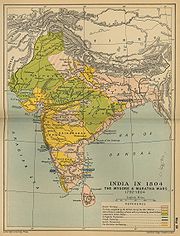
.jpg)
Royal Charter of 27 March 1668
The Royal Charter of 27 March 1668 was an agreement between the British Empire and the British East India Company. It led to the transfer of Bombay from Charles II of England to the British East India Company for an annual rent of £10...
led to the transfer of Bombay from Charles II to the British East India Company
British East India Company
The East India Company was an early English joint-stock company that was formed initially for pursuing trade with the East Indies, but that ended up trading mainly with the Indian subcontinent and China...
for an annual rent of £
Pound sterling
The pound sterling , commonly called the pound, is the official currency of the United Kingdom, its Crown Dependencies and the British Overseas Territories of South Georgia and the South Sandwich Islands, British Antarctic Territory and Tristan da Cunha. It is subdivided into 100 pence...
10 (equivalent retail price index of £1,226 in 2007). The islands were handed over to the Company on 23 September 1668. Upon the transfer, Bombay was made subordinate to the Company's settlement in Surat
Surat
Surat , also known as Suryapur, is the commercial capital city of the Indian state of Gujarat. Surat is India's Eighth most populous city and Ninth-most populous urban agglomeration. It is also administrative capital of Surat district and one of the fastest growing cities in India. The city proper...
. During 1668–87, the Governors of Bombay, who were also Presidents of Surat Council, spent most of their time in Surat. During this time, Bombay was administered by a Deputy Governor
Deputy Governor
A Deputy governor is a gubernatorial official who is subordinated to a governor, rather like a Lieutenant governor.-British colonial cases:In the British empire, there were such colonial offices in :...
.
In 1687, the Company shifted its main holdings from Surat to Bombay, which had become the administrative centre of all the west coast settlements. Following the transfer, Bombay was placed at the head of all the Company's establishments in India. However, the onset of plague and cholera delayed implementation, and the headquarters was not actually moved to Bombay until 1708. During the Governorships of John Gayer, Nicholas Waite, and William Aislabie (1694–1715), the Bombay Governors also held the title of "General". In 1703, Surat
Surat
Surat , also known as Suryapur, is the commercial capital city of the Indian state of Gujarat. Surat is India's Eighth most populous city and Ninth-most populous urban agglomeration. It is also administrative capital of Surat district and one of the fastest growing cities in India. The city proper...
was incorporated into Bombay Presidency.
During the 18th century, the Maratha Empire
Maratha Empire
The Maratha Empire or the Maratha Confederacy was an Indian imperial power that existed from 1674 to 1818. At its peak, the empire covered much of South Asia, encompassing a territory of over 2.8 million km²....
expanded rapidly, claiming Konkan
Konkan
The Konkan also called the Konkan Coast or Karavali is a rugged section of the western coastline of India from Raigad to Mangalore...
and much of eastern Gujarat from the disintegrating Mughal Empire
Mughal Empire
The Mughal Empire , or Mogul Empire in traditional English usage, was an imperial power from the Indian Subcontinent. The Mughal emperors were descendants of the Timurids...
. In western Gujarat, including Kathiawar
Kathiawar
Kathiawar or Kathiawad is a peninsula in western India, which is part of the Saurashtra region on the Arabian Sea coast of Gujarat state. It is bounded on the north by the great wetland of the Rann of Kutch, on the northwest by the Gulf of Kutch, on the west and south by the Arabian Sea, and on...
and Kutch, the loosening of Mughal control allowed numerous local rulers to create virtually independent states. In 1737, Salsette was captured by Baji Rao I
Baji Rao I
Shrimant Baji Rao Balaji Bhatt , also known as Baji Rao I, was a noted general who served as Peshwa to the fourth Maratha Chhatrapati Shahu from 1719 until Baji Rao's death. He is also known as Thorale Baji Rao...
of the Maratha Empire
Maratha Empire
The Maratha Empire or the Maratha Confederacy was an Indian imperial power that existed from 1674 to 1818. At its peak, the empire covered much of South Asia, encompassing a territory of over 2.8 million km²....
from the Portuguese, and the Portuguese province of Bassein was ceded to the Marathas in 1739. The growth of the Bengal provinces soon undermined Bombay's supremacy. In 1753, Bombay was made subordinate to Calcutta. Thereafter, Bengal always maintained much greater importance relative to Madras and Bombay. Bankot
Bankot
Bankot is a town in India. It was made part of Bombay Presidency in 1756.Its most famous structure is Bankot Fort . This was the first residency of the British Raj in Southern Konkan.-References:* * *...
(Fort Victoria) in Konkan was incorporated into Bombay Presidency in 1756. The First Anglo-Maratha War
First Anglo-Maratha War
The First Anglo-Maratha War was the first of three Anglo-Maratha wars fought between the British East India Company and Maratha Empire in India. The war began with the Treaty of Surat and ended with the Treaty of Salbai.-Background:...
began with the Treaty of Surat
Treaty of Surat
The Treaty of Surat was a treaty by which Raghunathrao, one of the claimants to the throne of the Peshwa, agreed to cede Salsette and Bassein Fort to the English, in consideration of being himself restored to Poona. The military operations that followed are known as the First Maratha War...
, which was signed on 6 March 1775, between Raghunathrao
Raghunathrao
Raghunathrao was Peshwa of the Maratha Confederacy from 1773 to 1774. He was instrumental in the downfall of the Peshwa clan.-Early life:Raghunathrao, also known as "Raghoba" and "Ragho Bharari," was the younger brother of Nanasaheb Peshwa. His father was Peshwa Bajirao I & mother was Kashibai....
of the Maratha Empire and the British. According to the treaty, Raghunathrao ceded Salsette and Bassein to the British. The war ended when Salsette, Elephanta
Elephanta Island
Elephanta Island is one of a number of islands in Mumbai Harbour, east of Mumbai, India...
, Hog Island
Hog Island, Mumbai
Hog Island is an island which lies in the Bombay Harbour about ten miles east of the Apollo pier. It gets its English name because it was here that ships used to be hogged.-References:* from Thana District Gazetteer...
, and Karanja
Karanja, Raigad
Karanja or Uran Island is a town in Raigad district about eight miles long and four broad, lies, in the south-east of Mumbai Harbour, about six miles south-east of the Carnac pier in Mumbai.-References:* from raigad...
were formally ceded to the British by the Treaty of Salbai
Treaty of Salbai
The Treaty of Salbai was signed on May 17, 1782, by representatives of the Maratha Empire and the British East India Company after long negotiations to settle the outcome of the First Anglo-Maratha War. Under its terms, the Company retained control of Salsette and acquired guarantees that the...
, signed on 17 May 1782. These territories were incorporated into the Bombay Presidency. Also according to the treaty, Bassein and its dependencies were restored to Raghunathrao, while Bharuch
Bharuch district
Bharuch in India, is a district in the southern part of the Gujarat peninsula on the west coast of state of Gujarat with a size and population comparable to that of Greater Boston...
was ceded to the Maratha ruler Scindia. The British annexed Surat on 15 May 1800. The British received the districts of Ahmadabad, Bharuch
Bharuch district
Bharuch in India, is a district in the southern part of the Gujarat peninsula on the west coast of state of Gujarat with a size and population comparable to that of Greater Boston...
and Kaira
Kheda district
Kheda district is one of the 26 districts of Gujarat state in western India. Kheda city is the administrative headquarters of the district.-History:...
in 1803 after British victory in the Second Anglo-Maratha War
Second Anglo-Maratha War
The Second Anglo-Maratha War was the second conflict between the British East India Company and the Maratha Empire in India.-Background:...
.
The framework of the Presidency formed between 1803 and 1827. The districts of Ahmadabad, Bharuch, and Kaira in Gujarat were taken over by the Bombay Government in 1805 and enlarged in 1818. The numerous small states of Kathiawar
Kathiawar
Kathiawar or Kathiawad is a peninsula in western India, which is part of the Saurashtra region on the Arabian Sea coast of Gujarat state. It is bounded on the north by the great wetland of the Rann of Kutch, on the northwest by the Gulf of Kutch, on the west and south by the Arabian Sea, and on...
and Mahikantha were organised into princely state
Princely state
A Princely State was a nominally sovereign entitity of British rule in India that was not directly governed by the British, but rather by an Indian ruler under a form of indirect rule such as suzerainty or paramountcy.-British relationship with the Princely States:India under the British Raj ...
s under British suzerainty between 1807 and 1820. Baji Rao II
Baji Rao II
Baji Rao II was the last Peshwa of the Maratha Confederacy, and governed from 1796 to 1818. His reign was marked by confrontations with the British.-Biography:...
, the last of the Maratha Peshwa
Peshwa
A Peshwa is the titular equivalent of a modern Prime Minister. Emporer Shivaji created the Peshwa designation in order to more effectively delegate administrative duties during the growth of the Maratha Empire. Prior to 1749, Peshwas held office for 8-9 years and controlled the Maratha army...
s, was defeated by the British in the Battle of Kirkee
Battle of Khadki
The Battle of Khadki took place at Khadki on November 5, 1817 between the forces of the British East India Company and those of Bajirao II, the Peshwa of the Maratha Empire...
, which took place near Poona in the Deccan on 5 November 1817. Following his defeat, the whole of the Deccan (except Satara
Satara district
Satara District is a district of Maharashtra state in western India with an area of 10,480 km² and a population of 2,808,994 of which 14.17% were urban . Satara is the capital of the district and other major towns include Wai, Karad, Koregaon, Koyananagar, Rahimatpur, Phaltan, Mahabaleshwar...
and Kolhapur
Kolhapur District
Kolhapur district is located in Maharashtra state. The city of Kolhapur is the district headquarters. The district had a population of 3,523,162 of which 29.81% were urban as of 2001...
), and certain parts of Gujarat, were included in the Presidency. The districts included were Khandesh
Khandesh
Khandesh is a region of central India, which forms the northwestern portion of Maharashtra state.Khandesh was the terminal territorial part under the rule of Mughals. The Start of Deccan region demarcated by the boundary of Khandesh....
, Belgaum
Belgaum district
Belgaum district is a district in the state of Karnataka, India. The city of Belgaum is the district headquarters in North Karnataka. By the 2011 Census of India, it had a population of 4778439...
, Dharwar
Dharwad District
Dharwad District is an administrative district of the state of Karnataka in southern India. Dharwad is the cultural headquarters of North Karnataka....
, Ratnagiri
Ratnagiri District
Ratnagiri district is one of the 35 districts of Maharashtra state in western India. Ratnagiri is the district headquarters of the district. The district is 11.33% urban. The district is bounded by the Arabian Sea to the west, Sindhudurg district to the south, Raigad district to the north and...
, Kolaba (except Alibag
Alibag
Alibag or Alibaug or Alibagh is a coastal town and a municipal council in Raigad District in the Konkan region of Maharashtra, India. It is also the headquarters of the Raigad district. The town and its surrounding villages are the historic hinterland of Bene Israeli Jews...
taluka), Poona
Pune District
Pune District is situated in Maharashtra state of India. Pune city is the district headquarters. In the last census on 2001, the total population of the district was 7,232,555, making it the fourth most populous district in India . Urban population comprises 58.08% of the total population...
, Ahmadnagar
Ahmednagar district
Ahmednagar district is the largest district of Maharashtra state in western India. The historical Ahmednagar city is the headquarters of the district. Ahmednagar was the seat of the Ahmednagar Sultanate of late medieval period . This district is also known for the towns of Shirdi associated with...
, Nasik. Aden
Aden
Aden is a seaport city in Yemen, located by the eastern approach to the Red Sea , some 170 kilometres east of Bab-el-Mandeb. Its population is approximately 800,000. Aden's ancient, natural harbour lies in the crater of an extinct volcano which now forms a peninsula, joined to the mainland by a...
was incorporated in 1839. Alibag taluka was annexed in 1840 and added to the Presidency. Sind
Sind Division
The Sind Division was the name of Sindh after being annexed by the Bombay Presidency province of British India in 1843 , following a British Indian conquest led by then Major-General Charles Napier. The region separated from the Bombay Presidency to become the Sind Province on 1936-04-01....
province, which included the districts of Karachi
Karachi
Karachi is the largest city, main seaport and the main financial centre of Pakistan, as well as the capital of the province of Sindh. The city has an estimated population of 13 to 15 million, while the total metropolitan area has a population of over 18 million...
, Hyderabad
Hyderabad District (Pakistan)
Hyderābād District , is a district of Sindh, Pakistan. It used to be an administrative division of the Sindh namely the Hyderabad Division, until the reforms of 2000 abolished the third tier of government. Its capital is the city of Hyderabad. The Kirthar National Park is located in Hyderabad...
, Shikarpur
Shikarpur District
Shikarpur district is a district in the Sindh province of Pakistan. The city of Shikarpur is the capital. It is spread over an area of 2,512 km2, according to the 1998 census of Pakistan it had a population of 880,438 of which 23.51% were urban....
, Thar and Parkar, and Upper Sind Frontier
Upper Sind Frontier District
Upper Sind Frontier District was a district of the Bombay Presidency during British Rule. The district was the northernmost portion of Sind and lay between 27°56' and 28° 27' N. and 68° and 69° 44' E., with an area of...
, were annexed in 1847. In 1848, the districts of Satara
Satara district
Satara District is a district of Maharashtra state in western India with an area of 10,480 km² and a population of 2,808,994 of which 14.17% were urban . Satara is the capital of the district and other major towns include Wai, Karad, Koregaon, Koyananagar, Rahimatpur, Phaltan, Mahabaleshwar...
and Bijapur were added to the Presidency. In 1853, Panch Mahal
Panchmahal district
Panchmahal, also Panch Mahals, is a district in the western India, in the eastern portion of Gujarat State. Panch-mahal means "five tehsils/talukas" , and refers to the five sub-divisions namely - Godhra, Dahod, Halol, Kalol and Jhalod that were transferred by the Maharaja Sindia of Gwalior to the...
s in Gujarat was leased from the Scindias. The Canara
Kanara
The Kanara or Canara region comprises three coastal districts of Karnataka, namely Dakshina Kannada, Udupi and Uttara Kannada and Kasaragod district of Kerala in southwestern India. Kanara forms the southern part of the Konkan coast...
district, which was under Madras Presidency, was bifurcated into North Canara and South Canara
South Canara
South Canara was a district under the British empire, located at . It was bifurcated in 1859 from Canara district. It was the undivided Dakshina Kannada district...
in 1860. South Canara remained under Madras Presidency, while North Canara was transferred to Bombay Presidency in 1861. Between 1818 and 1858, certain princely states lke Mandvi
Mandvi
Mandvi is a city and a Municipality in Kachchh district in the Indian state of Gujarat. It was once a major port of the region and summer retreat for Maharao of the Kachchh. The old city had a surrounding fort, and remains of the fort wall can still be seen to this day...
in Surat and some in Satara were lapsed to the Presidency.
| # | Name | Portrait | Assumed office | Left office | Years in office | Remarks |
|---|---|---|---|---|---|---|
| 1 | George Oxeden | 23 September 1668 | 14 July 1669 | 1 | ||
| 2 | Matthew Gray Matthew Gray (Governor of Bombay) -References:*... |
14 July 1669 | 7 June 1672 | 3 | Acting | |
| 3 | Gerald Aungier Gerald Aungier Gerald Aungier was the second Governor of Bombay. He was made the president of the Surat factory and the governor of Bombay in 1672, which posts he held till 1675... |
7 June 1672 | 30 June 1677 | 5 | ||
| 4 | Henry Oxenden | 30 June 1677 | 27 October 1681 | 4 | ||
| 5 | John Child | 27 October 1681 | 27 December 1683 | 2 | ||
| 6 | Richard Keigwin | 27 December 1683 | 19 November 1684 | 1 | Acting | |
| 7 | Charles Zinzan | 19 November 1684 | 1685 | 1 | Acting | |
| 8 | John Wyborne | 1685 | 2 May 1687 | 2 | Acting | |
| 9 | John Child | 2 May 1687 | 4 Feb 1690 | 3 | ||
| 10 | Bartholomew Harris Bartholomew Harris Bartholomew Harris was a governor of Bombay during the British Raj. He assumed the office on February 4, 1690. He left office on 10 May 1694.... |
4 February 1690 | 10 May 1694 | 4 | ||
| 11 | Daniel Annesley Daniel Annesley Daniel Annesley was an English governor of the Bombay Presidency in the days of the Honourable East India Company. He assumed the office on 10 May 1694 and left office on 17 May 1694.... |
10 May 1694 | 17 May 1694 | Acting | ||
| 12 | John Gayer | 17 May 1694 | November 1704 | 10 | ||
| 13 | Nicholas Waite | November 1704 | September 1708 | 4 | ||
| 14 | William Aislabie | September 1708 | 11 October 1715 | 7 | ||
| 15 | Stephen Strutt Stephen Strutt Stephen Strutt was the former governor of Mumbai during the British Raj. He assumed the office on 11 October 1715. He left office on 26 December 1715.... |
11 October 1715 | 26 December 1715 | Acting | ||
| 16 | Charles Boone Charles Boone Charles Boone was a British governor of the Bombay Presidency during the period of the Honourable East India Company, serving from 1715 to 1722.... |
26 December 1715 | 9 January 1722 | 7 | ||
| 17 | William Phipps | 9 January 1722 | 10 January 1729 | 7 | ||
| 18 | Robert Cowan Robert Cowan Robert Cowan was an Irish colonial administrator and the East India Company's Governor of Bombay from 1729 to 1734. He was a collateral ancestor of the Marquesses of Londonderry through the marriage of his sister, Mary Cowan, to Alexander Stewart, father of Robert Stewart, 1st Marquess of... |
10 January 1729 | 22 September 1734 | 5 | ||
| 19 | John Horne John Horne (Governor of Bombay) John Horne was the Governor of Bombay from 22 September 1734 to 7 April 1739.... |
22 September 1734 | 7 April 1739 | 5 | ||
| 20 | Stephen Law Stephen Law (Governor of Bombay) Stephen Law was the Governor of Bombay from 7 April 1739 to 15 November 1742.Law retired to Broxbourne Manor, Broxbourne. After his wife died in January 1785, he moved to Goudhurst in Kent.... |
7 April 1739 | 15 November 1742 | 3 | ||
| 21 | John Geekie John Geekie John Geekie was the British governor of Bombay from 15 November 1742 to 26 November 1742, during the rule of the Honourable East India Company.-References:*... |
15 November 1742 | 26 November 1742 | Acting | ||
| 22 | William Wake William Wake (governor) William Wake was the governor of Bombay during the British Raj from 26 November 1742 to 17 November 1750.-References:*http://books.google.com/books?id=3VQTAAAAYAAJ&printsec=toc#PRA1-PA126,M1... |
26 November 1742 | 17 November 1750 | 8 | ||
| 23 | Richard Bourchier Richard Bourchier Richard Bourchier was the former governor of Mumbai during the British Raj from 1750 to 1760.... |
17 November 1750 | 1760 | 10 | ||
| 24 | John Holkell John Holkell -References:*... |
1760 | 28 February 1760 | Acting | ||
| 25 | Charles Crommelin Charles Crommelin Charles Crommelin was the former governor of Mumbai during the British Raj from 1760 to 1767.Crommelin was born in Bombay, where his father, Marc Anthony Crommelin was a factor for the British East India Company. Charles first joined the staff of the East India Company in 1733-Sources:*... |
28 February 1760 | 27 January 1767 | 7 | ||
| 26 | Thomas Hodges Thomas Hodges (Governor of Bombay) Thomas Hodges was the Governor of Bombay from 27 January 1767 to 23 February 1771.Thomas Hodges was the son of Thomas Hodges of Bredy, Dorset. He married a daughter of Colonel Hallett of Barbados; their son, Thomas Hallett Hodge, married a daughter of the political reformer John Cartwright.... |
27 January 1767 | 23 February 1771 | 4 | ||
| 27 | William Hornby | 26 February 1771 | 1 January 1784 | 13 | ||
| 28 | Rawson Hart Boddam Rawson Hart Boddam Rawson Hart Boddam was the former Governor of the Bombay Presidency during the rule of the East India Company in British India from 1784–1788.Boddam entered East India Company service in 1752... |
1 January 1784 | 9 January 1788 | 4 | ||
| 29 | Andrew Ramsay Andrew Ramsay (governor) Andrew Ramsay was the officiating governor of Bombay during the British Raj from 9 January 1788 to 6 September 1788.-References:*http://books.google.com/books?id=3VQTAAAAYAAJ&printsec=toc#PRA1-PA126,M1... |
9 January 1788 | 6 September 1788 | 1 | Acting | |
| 30 | William Medows William Medows General Sir William Medows KB was an Englishman and a general in the British Army.-Military career:Sir William was the son of Philip Medows, deputy ranger of Richmond Park, and Lady Frances Pierrepont, daughter of the Duke of Kingston-upon-Hull.He entered the British Army as an ensign in the 50th... |
 |
6 September 1788 | 21 January 1790 | 2 | |
| 31 | Robert Abercromby |  |
21 January 1790 | 26 November 1792 | 2 | |
| 32 | George Dick George Dick (Governor of Bombay) George Dick was the Governor of Bombay from 26 November 1792 to 9 November 1795.Dick became a writer for the East India Company in 1759. At the time of his death he "had never been out of Bombay, except for an occasional trip to Bancoot, for nearly sixty years." There is a tablet to his memory in... |
26 November 1792 | 9 November 1795 | 3 | Acting | |
| 33 | John Griffith John Griffith (Governor of Bombay) -References:... |
9 November 1795 | 27 December 1795 | Acting | ||
| 34 | Jonathan Duncan Jonathan Duncan (Governor of Bombay) Jonathan Duncan was Governor of Bombay from 27 December 1795 until his death in 1811.He began his career in India in 1772, and in 1788 was appointed superintendent and resident at Benares by Lord Cornwallis, where he helped stamp out the practice of infanticide... |
27 December 1795 | 11 August 1811 | 16 | ||
| 35 | George Brown G. Brown G. Brown was the British Governor of Bombay from 1811 to 1812, during the period of the Honourable East India Company's rule in India.... |
11 August 1811 | 12 August 1812 | 1 | Acting | |
| 36 | Evan Nepean Evan Nepean Sir Evan Nepean, 1st Baronet PC was a British politician and colonial administrator.-Early career:... |
12 August 1812 | 1 November 1819 | 7 | ||
| 37 | Mountstuart Elphinstone Mountstuart Elphinstone Mountstuart Elphinstone was a Scottish statesman and historian, associated with the government of British India. He later became the Governor of Bombay where he is credited with the opening of several educational institutions accessible to the Indian population... |
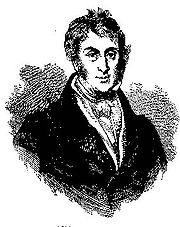 |
1 November 1819 | 1 November 1827 | 8 | |
| 38 | John Malcolm John Malcolm Major-general Sir John Malcolm was a Scottish soldier, statesman, and historian-Early life:Born at Burnfoot, Dumfriesshire, Malcolm was the son of George Malcolm, a gentleman farmer of Eskdale and Burnfoot. Jock, as he was then known, was one of the four Malcolm brothers who attained knighthoods... |
1 November 1827 | 1 December 1830 | 3 | ||
| 39 | Thomas Sidney Beckwith | 1 December 1830 | 15 January 1831 | 1 | Acting | |
| 40 | John Romer John Romer (politician) John Romer was the former officiating governor of Bombay during the British Raj from 17 January 1831 to 21 March 1831.-References:*http://books.google.com/books?id=3VQTAAAAYAAJ&printsec=toc#PRA1-PA126,M1... |
17 January 1831 | 21 March 1831 | Acting | ||
| 41 | John FitzGibbon John FitzGibbon, 2nd Earl of Clare John FitzGibbon, 2nd Earl of Clare KP GCH PC was the son of John FitzGibbon, 1st Earl of Clare and his wife, Anne. He succeeded to the titles of Baron FitzGibbon in the Peerage of Great Britain and Earl of Clare in the Irish Peerage in 1802.-Biography:FitzGibbon was educated at Harrow School and... |
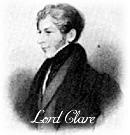 |
21 March 1831 | 17 March 1835 | 4 | |
| 42 | Robert Grant Robert Grant (MP) Sir Robert Grant GCH was a British lawyer and politician.He was born in India, the son of Charles Grant, chairman of the Directors of the Honourable East India Company, and younger brother of Charles Grant, later Lord Glenelg. Returning home with their father in 1790, the two brothers were entered... |
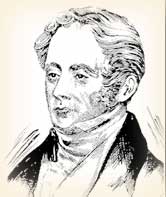 |
17 March 1835 | 9 July 1838 | 3 | |
| 43 | James Farish James Farish James Farish was the officiating governor of Bombay during the British Raj from 11 July 1838 to 31 May 1839.-References:*http://books.google.com/books?id=3VQTAAAAYAAJ&printsec=toc#PRA1-PA126,M1... |
11 July 1838 | 31 May 1839 | 1 | Acting | |
| 44 | James Rivett Carnac | 31 May 1839 | 27 April 1841 | 2 | ||
| 45 | William Hay Macnaghten | 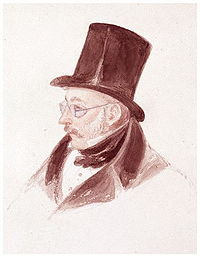 |
27 April 1841 | 28 April 1841 | Acting | |
| 46 | George William Anderson George William Anderson George William Anderson was the officiating governor of Bombay during the British Raj from 28 April 1841 to 9 June 1842.... |
28 April 1841 | 9 June 1842 | 1 | Acting | |
| 47 | George Arthur George Arthur Lieutenant-General Sir George Arthur, 1st Baronet KCH PC was Lieutenant Governor of British Honduras , Van Diemen's Land and Upper Canada . He also served as Governor of Bombay .-Early life:George Arthur was born in Plymouth, England... |
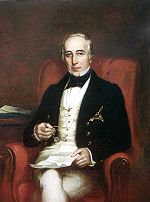 |
9 June 1842 | 6 August 1846 | 4 | |
| 48 | Lestock Robert Reid Lestock Robert Reid Lestock Robert Reid was the former governor of Mumbai during the British Raj from 1846–1847.-References:*... |
6 August 1846 | 23 January 1847 | 1 | Acting | |
| 49 | George Russell Clerk George Russell Clerk Sir George Russell Clerk, GCSI, KCB was a British civil servant in India.Like all civil servants until the introduction of Competitive examinations in the 1850s, Clerk had studied at Haileybury in Hertfordshire, being posted to Bengal as a writer in 1817.Early in his career he worked in the... |
23 January 1847 | 1 May 1848 | 1 | Acting | |
| 50 | Lucius Cary (Lord Falkland) Lucius Cary, 10th Viscount Falkland Lucius Bentinck Cary, 10th Viscount Falkland GCH, PC was a British colonial administrator and Liberal politician.-Background:Falkland was the son of Charles John Cary, 9th Viscount Falkland, and his wife Christiana... |
1 May 1848 | 26 December 1853 | 5 | ||
| 51 | John Elphinstone (Lord Elphinstone) John Elphinstone, 13th Lord Elphinstone John Elphinstone, 13th Lord Elphinstone and 1st Baron Elphinstone GCB GCH PC was a Scottish soldier, politician and colonial administrator. He was twice elected to the Parliament of the United Kingdom as a Scottish Representative peer, serving once from 14 January 1833 to 29 December 1834 and then... |
26 December 1853 | 11 May 1860 | 7 | ||
| 52 | George Russell Clerk George Russell Clerk Sir George Russell Clerk, GCSI, KCB was a British civil servant in India.Like all civil servants until the introduction of Competitive examinations in the 1850s, Clerk had studied at Haileybury in Hertfordshire, being posted to Bengal as a writer in 1817.Early in his career he worked in the... |
11 May 1860 | 24 April 1862 | 2 | Acting |
Sources: The India List and India Office List and Oxford Dictionary of National Biography
Graphical
Deputy Governors of Bombay (1668–1690)
The transfer of the headquarters of the Company's power to Bombay largely eliminated the need for a Deputy Governor
Deputy Governor
A Deputy governor is a gubernatorial official who is subordinated to a governor, rather like a Lieutenant governor.-British colonial cases:In the British empire, there were such colonial offices in :...
. In spite of the change, the title continued to be borne by the second member of the Executive Council
Executive Council (Commonwealth countries)
An Executive Council in Commonwealth constitutional practice based on the Westminster system is a constitutional organ which exercises executive power and advises the governor or governor-general. Executive Councils often make decisions via Orders in Council.Executive Councillors are informally...
of the Governor. It fell into disuse sometime between 1720 and 1758.
| # | Name | Assumed office | Left office | Years in office |
|---|---|---|---|---|
| 1 | Henry Young Captain Henry Young -References:*http://books.google.com/books?id=miD5YO05jpUC&printsec=frontcover#PPA324,M1... |
1668 | 13 November 1669 | 2 |
| 2 | Matthew Gray Matthew Gray (Governor of Bombay) -References:*... |
1670 | 1670 | |
| 3 | Phillip Gifford Phillip Gifford -References:*http://books.google.com/books?id=miD5YO05jpUC&printsec=frontcover#PPA324,M1... |
1670 | 1676 | 6 |
| 4 | Henry Oxenden | 1676 | 1682 | 6 |
| 5 | Charles Ward Charles Ward (Deputy Governor of Bombay) Charles Ward was the Deputy Governor of Bombay from 1682 to 1683. He was appointed to the office by his brother-in-law John Child with the intention that he should reduce the costs of operations for the East India Company in Bombay... |
1682 | 1683 | 1 |
| 6 | Charles Zinzan | 1684 | 1686 | 2 |
| 7 | John Wyborne John Wyborne Sir John Wyborne was an English governor of Bombay during the period of the Honourable East India Company. He assumed the office in 1686 and left office on February 4, 1690.... |
1686 | 1688 | 2 |
| 8 | John Vaux John Vaux -References:*http://books.google.com/books?id=miD5YO05jpUC&printsec=frontcover#PPA324,M1... |
1689 | 1689 | |
| 9 | George Cooke George Cooke (Deputy Governor of Bombay) -References:*http://books.google.com/books?id=miD5YO05jpUC&printsec=frontcover#PPA324,M1... |
1689 | 1690 | 1 |
| 10 | George Weldon George Weldon (Deputy Governor of Bombay) -References:*http://books.google.com/books?id=miD5YO05jpUC&printsec=frontcover#PPA324,M1... |
1690 | 1690 | |
| 11 | Samuel Burniston Samuel Burniston (Deputy Governor of Bombay) -References:*http://books.google.com/books?id=miD5YO05jpUC&printsec=frontcover#PPA324,M1... |
1690 | 1704 | 14 |
Source: Origin of Bombay
Graphical
Crown Governors (1862–1948)
.jpg)
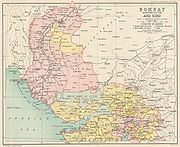
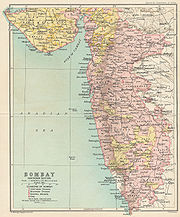
Indian Rebellion of 1857
The Indian Rebellion of 1857 began as a mutiny of sepoys of the British East India Company's army on 10 May 1857, in the town of Meerut, and soon escalated into other mutinies and civilian rebellions largely in the upper Gangetic plain and central India, with the major hostilities confined to...
, the Company was accused of mismanagement, and Bombay reverted to the British Crown. On 2 August 1858, the British Parliament
Parliament of the United Kingdom
The Parliament of the United Kingdom of Great Britain and Northern Ireland is the supreme legislative body in the United Kingdom, British Crown dependencies and British overseas territories, located in London...
began abolition of the Company and asserted full, direct Crown authority over India. The execution was slow. The Company for purposes of liquidation
Liquidation
In law, liquidation is the process by which a company is brought to an end, and the assets and property of the company redistributed. Liquidation is also sometimes referred to as winding-up or dissolution, although dissolution technically refers to the last stage of liquidation...
maintained its formal existence until 1874. India was thereafter directly ruled by the Crown as a colony of the United Kingdom, and officially known as the Empire of India after 1876. India consisted of some regions referred to as British India that were directly administered by the British and other regions called the Princely State
Princely state
A Princely State was a nominally sovereign entitity of British rule in India that was not directly governed by the British, but rather by an Indian ruler under a form of indirect rule such as suzerainty or paramountcy.-British relationship with the Princely States:India under the British Raj ...
s that were ruled by Indian rulers.
Laws were made for British India by a Legislative Council under the Viceroy
Governor-General of India
The Governor-General of India was the head of the British administration in India, and later, after Indian independence, the representative of the monarch and de facto head of state. The office was created in 1773, with the title of Governor-General of the Presidency of Fort William...
having wide powers of legislation. This Council could pass laws as important as any Acts by the British Parliament. The Legislative Council was made of six members besides the Viceroy. In addition, the governors served as extraordinary members when the Legislative Council met in their provinces. They also had an Executive Council
Executive Council (Commonwealth countries)
An Executive Council in Commonwealth constitutional practice based on the Westminster system is a constitutional organ which exercises executive power and advises the governor or governor-general. Executive Councils often make decisions via Orders in Council.Executive Councillors are informally...
of two members of the Indian Civil Service for 12 years standing, appointed by the Crown.
The Governor would consult the Executive Council in the exercise of all his functions (except on trivial or urgent matters or where the public interest made it undesirable). He would not be required to consult in cases where he was specifically authorised by the Constitution to act in his discretion or on the advice of, or after consultation with, some other person or authority. He would in general act in accordance with the advice of the Executive Council but could act against such advice, where he considered it necessary in the interests of the public order, public faith or good government; in such cases he would be required to seek approval of the Secretary of State for India
Secretary of State for India
The Secretary of State for India, or India Secretary, was the British Cabinet minister responsible for the government of India and the political head of the India Office...
.
The Governor didn't have the right to make or suspend any laws, unless in cases of urgent necessity, he could do it with the consent of the Governor-General of India. He didn't have the power of creating a new office, or granting any salary, gratuity, or allowance, without the sanction of the Governor-General of India. The Governor-General had full power to superintend and control the Governor in all points relating to the civil or military administration of the Presidency, and the Governor had to obey the orders and instructions of the Governor-General in all cases. The Governors could propose to the Governor-General drafts of any laws which they thought expedient, together with their reasons for the same; and the Governor-General communicated the resolutions to the Governor, after considering the reasons. The Governors regularly transmitted to the Governor-General true copies of all orders and acts of their governments, and also advice of all matters which they felt to be communicated to the Governor-General. The powers of the Governors were not suspended when the Governor-General visited the Presidency. The departure of the Governor from India with intent to return to Europe was deemed to be a resignation from his office. Alternately, the Governor could resign by declaring it in writing and delivering it to the secretary for the public department of the Presidency.
In 1906, Bombay Presidency had four commissionerships and twenty-six districts with Bombay City as its capital. The four commissionerships were the northern province of Gujarat, the central province of Deccan, the southern province of Carnatic
Carnatic region
The Carnatic coast is the region of South India lying between the Eastern Ghats and the Coromandel Coast, in the modern Indian states of Tamil Nadu, south eastern Karnataka and southern Andhra Pradesh....
, and the northwestern province of Sind
Sind Division
The Sind Division was the name of Sindh after being annexed by the Bombay Presidency province of British India in 1843 , following a British Indian conquest led by then Major-General Charles Napier. The region separated from the Bombay Presidency to become the Sind Province on 1936-04-01....
. The 26 districts were Bombay City
Mumbai City District
Mumbai City District is a district of Maharashtra in Konkan Division. As a city district, it has no headquarters or subdivisions. It, along with the Mumbai Suburban District make up the metropolis of Mumbai. The city area is called the "island city" or South Mumbai or Old Mumbai. It extends from...
, Bombay Island
Isle of Bombay
thumb|right|The original islandsIsle of Bombay was one of Seven islands of Bombay that were merged to create the city of Bombay. The island has a natural harbour to the east and Malabar hills to west.- References:*...
, Ahmedabad, Bharuch
Bharuch district
Bharuch in India, is a district in the southern part of the Gujarat peninsula on the west coast of state of Gujarat with a size and population comparable to that of Greater Boston...
, Kaira
Kheda district
Kheda district is one of the 26 districts of Gujarat state in western India. Kheda city is the administrative headquarters of the district.-History:...
, Panch Mahal
Panchmahal district
Panchmahal, also Panch Mahals, is a district in the western India, in the eastern portion of Gujarat State. Panch-mahal means "five tehsils/talukas" , and refers to the five sub-divisions namely - Godhra, Dahod, Halol, Kalol and Jhalod that were transferred by the Maharaja Sindia of Gwalior to the...
, Surat
Surat district
Surat is a district in the state of Gujarat India with Surat city as the administrative headquarters of this district. It is surrounded by Bharuch, Narmada , Navsari and Dang districts. To the west is the Gulf of Cambay. It is the second-most advanced district in Gujarat...
, Thana
Thane District
Thane is a district in northern Maharashtra state in western India. As of 2011 it is the most populated district in the nation. The headquarters of the district is the city of Thane. Other major cities in the district are Navi Mumbai , Kalyan-Dombivli, Mira-Bhayander, Bhiwandi, Ulhasnagar,...
, Ahmednagar
Ahmednagar district
Ahmednagar district is the largest district of Maharashtra state in western India. The historical Ahmednagar city is the headquarters of the district. Ahmednagar was the seat of the Ahmednagar Sultanate of late medieval period . This district is also known for the towns of Shirdi associated with...
, East Khandesh, West Khandesh, Nasik
Nashik district
Nashik district, also known as Nasik district, is a district in Maharashtra, India. The city of Nashik is the administrative headquarters of the district.-Geography:Nashik district has an area of 15,530 square kilometres...
, Poona
Pune District
Pune District is situated in Maharashtra state of India. Pune city is the district headquarters. In the last census on 2001, the total population of the district was 7,232,555, making it the fourth most populous district in India . Urban population comprises 58.08% of the total population...
, Satara
Satara district
Satara District is a district of Maharashtra state in western India with an area of 10,480 km² and a population of 2,808,994 of which 14.17% were urban . Satara is the capital of the district and other major towns include Wai, Karad, Koregaon, Koyananagar, Rahimatpur, Phaltan, Mahabaleshwar...
, Solapur
Solapur District
- Solapur District is a district in Maharashtra state of India. The city of Solapur is the district headquarters. It is located on the south east edge of the state and lies entirely in the Bhima and Seena basins. The entire district is drained by the Bhima River.Solapur district leads in beedi...
, Belgaum
Belgaum district
Belgaum district is a district in the state of Karnataka, India. The city of Belgaum is the district headquarters in North Karnataka. By the 2011 Census of India, it had a population of 4778439...
, Bijapur, Dharwar
Dharwad District
Dharwad District is an administrative district of the state of Karnataka in southern India. Dharwad is the cultural headquarters of North Karnataka....
, North Canara, Kolaba
Raigad district
Raigad District , also known as Raigarh District, is a district in the Indian state of Maharashtra. It is located in the Konkan region. The district was renamed after Raigad, the fort which was the former capital of the Maratha leader Shivaji, and is located in the interior regions of the district,...
, Ratnagiri
Ratnagiri District
Ratnagiri district is one of the 35 districts of Maharashtra state in western India. Ratnagiri is the district headquarters of the district. The district is 11.33% urban. The district is bounded by the Arabian Sea to the west, Sindhudurg district to the south, Raigad district to the north and...
, Karachi
Karachi
Karachi is the largest city, main seaport and the main financial centre of Pakistan, as well as the capital of the province of Sindh. The city has an estimated population of 13 to 15 million, while the total metropolitan area has a population of over 18 million...
, Hyderabad
Hyderabad District (Pakistan)
Hyderābād District , is a district of Sindh, Pakistan. It used to be an administrative division of the Sindh namely the Hyderabad Division, until the reforms of 2000 abolished the third tier of government. Its capital is the city of Hyderabad. The Kirthar National Park is located in Hyderabad...
, Shikarpur
Shikarpur District
Shikarpur district is a district in the Sindh province of Pakistan. The city of Shikarpur is the capital. It is spread over an area of 2,512 km2, according to the 1998 census of Pakistan it had a population of 880,438 of which 23.51% were urban....
, Thar and Parkar, and Upper Sind Frontier
Upper Sind Frontier District
Upper Sind Frontier District was a district of the Bombay Presidency during British Rule. The district was the northernmost portion of Sind and lay between 27°56' and 28° 27' N. and 68° and 69° 44' E., with an area of...
. Aden
Aden
Aden is a seaport city in Yemen, located by the eastern approach to the Red Sea , some 170 kilometres east of Bab-el-Mandeb. Its population is approximately 800,000. Aden's ancient, natural harbour lies in the crater of an extinct volcano which now forms a peninsula, joined to the mainland by a...
separated from Bombay Presidency in 1932, and Sind separated in 1936.
| # | Name | Portrait | Assumed office | Left office | Years in office | Remarks |
|---|---|---|---|---|---|---|
| 1 | Henry Bartle Frere Henry Bartle Frere Sir Henry Bartle Edward Frere, 1st Baronet, GCB, GCSI, was a British colonial administrator.-Early life:Frere was born at Clydach House, Clydach, Monmouthshire, the son of Edward Frere, manager of Clydach Ironworks... |
 |
24 April 1862 | 6 March 1867 | 5 | |
| 2 | William Robert Seymour Vesey Fitzgerald | 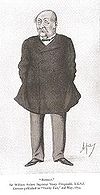 |
6 March 1867 | 6 May 1872 | 5 | |
| 3 | Philip Edmond Wodehouse | 6 May 1872 | 30 April 1877 | 5 | ||
| 4 | Richard Temple Sir Richard Temple, 1st Baronet Sir Richard Temple, 1st Baronet, FRS, GCSI, CIE, PC was an administrator in British India and a British politician.-Career:... |
30 April 1877 | 13 March 1880 | 3 | ||
| 5 | Lionel Robert Ashburner Lionel Robert Ashburner Lionel Robert Ashburner was the Acting governor of Bombay during the British Raj from 13 March 1880 to 28 April 1880.-References:*http://books.google.com/books?id=3VQTAAAAYAAJ&printsec=toc#PRA1-PA126,M1... |
13 March 1880 | 28 April 1880 | Acting | ||
| 6 | James Fergusson Sir James Fergusson, 6th Baronet Sir James Fergusson, 6th Baronet GCSI, PC was a British soldier, Conservative politician and colonial administrator.-Background and education:... |
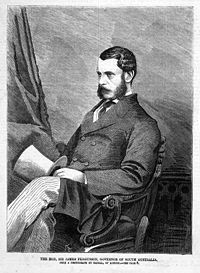 |
28 April 1880 | 27 March 1885 | 5 | |
| 7 | James Braithwaite Peile James Braithwaite Peile James Braithwaite Peile was the Acting governor of Bombay during the British Raj from 27 March 1885 to 30 March 1885.-References:*http://books.google.com/books?id=3VQTAAAAYAAJ&printsec=toc#PRA1-PA126,M1James Peile... |
27 March 1885 | 30 March 1885 | Acting | ||
| 8 | Donald Mackay (Lord Reay) | 30 March 1885 | 12 April 1890 | 5 | ||
| 9 | George Harris George Harris, 4th Baron Harris George Robert Canning Harris, 4th Baron Harris, GCSI, GCIE was a British politician, cricketer and cricket administrator... |
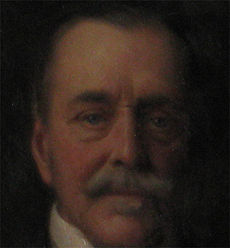 |
27 March 1890 | 16 February 1895 | 5 | |
| 10 | Herbert Mills Birdwood Herbert Mills Birdwood Herbert Mills Birdwood was the Acting governor of Bombay during the British Raj from 16 February 1895 to 18 February 1895.Birdwood was educated at Plymouth Grammar School, at Exeter, at Edinburgh University and at Peterhouse, Cambridge. He married Edith Marion Sidonie Impey the daughter of... |
16 February 1895 | 18 February 1895 | Acting | ||
| 11 | William Mansfield (Lord Sandhurst) William Mansfield, 1st Viscount Sandhurst William Mansfield, 1st Viscount Sandhurst GCSI, GCIE, GCVO, PC was a British Liberal politician and colonial governor... |
.jpg) |
18 February 1895 | 17 February 1900 | 5 | |
| 12 | Henry Northcote Henry Northcote, 1st Baron Northcote Henry Stafford Northcote, 1st Baron Northcote GCMG, GCIE, CB, PC , known as Sir Henry Northcote, Bt, between 1887 and 1900, was a Conservative politician and colonial administrator... |
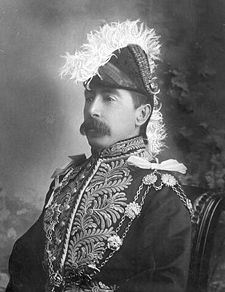 |
17 February 1900 | 5 September 1903 | 3 | |
| 13 | James Monteath | 5 September 1903 | 12 December 1903 | Acting | ||
| 14 | Charles Cochrane Baillie (Lord Lamington) |  |
12 December 1903 | 27 July 1907 | 4 | |
| 15 | John William Pitt Sir John William Pitt Muir-Mackenzie Sir John William Pitt Muir Mackenzie was the Acting governor of Bombay during the British Raj from 27 July 1907 to 18 October 1907.He was the son of Sir John William Pitt Muir Mackenzie, 2nd Baronet.-References:... |
27 July 1907 | 18 October 1907 | Acting | ||
| 16 | George Sydenham Clarke | 18 October 1907 | 5 April 1913 | 6 | ||
| 17 | Freeman Thomas (Lord Willingdon) Freeman Freeman-Thomas, 1st Marquess of Willingdon Major Freeman Freeman-Thomas, 1st Marquess of Willingdon was a British Liberal politician and administrator who served as Governor General of Canada, the 13th since Canadian Confederation, and as Viceroy and Governor-General of India, the country's 22nd.Freeman-Thomas was born in England and... |
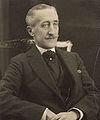 |
5 April 1913 | 16 December 1918 | 5 | |
| 18 | George Lloyd | 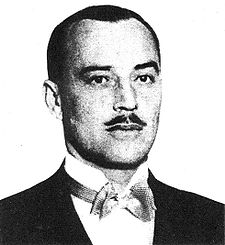 |
16 December 1918 | 8 December 1923 | 5 | |
| 19 | Maurice Hayward Maurice Hayward (Governor of Bombay) Maurice Hayward was the Acting governor of Bombay during the British Raj from 8 December 1923 to 10 December 1923.... |
8 December 1923 | 10 December 1923 | Acting | ||
| 20 | Leslie Orme Wilson Leslie Orme Wilson Sir Leslie Orme Wilson, GCSI, GCMG, GCIE, DSO, PC was a British soldier, Conservative politician and Governor of Queensland.-Personal life:... |
10 December 1923 | 20 March 1926 | 3 | ||
| 21 | Henry Staveley Lawrence Henry Staveley Lawrence Henry Staveley Lawrence was the Acting governor of Bombay during the British Raj from 20 March 1926 to 8 December 1928.... |
20 March 1926 | 8 December 1928 | 2 | Acting | |
| 22 | Frederick Sykes Frederick Sykes Air Vice-Marshal The Right Honourable Sir Frederick Hugh Sykes GCSI, GCIE, GBE, KCB, CMG was a military officer, British statesman and politician.... |
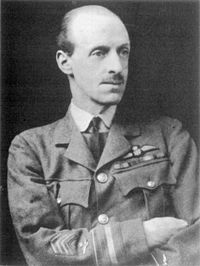 |
9 December 1928 | 9 December 1933 | 5 | |
| 23 | John Ernest Buttery Hotson John Ernest Buttery Hotson Sir John Ernest Buttery Hotson, KCSI, OBE, VD was an administrator in India during the British Raj. Born in Glasgow to Hamilton and Margaret Hotson, he was educated at Edinburgh Academy and Magdalen College, Oxford, graduating BA in 1899, and MA... |
1931 | 1931 | Acting | ||
| 24 | Michael Knatchbull (Lord Brabourne) Michael Knatchbull, 5th Baron Brabourne Michael Herbert Rudolf Knatchbull, 5th Baron Brabourne, GCSI, GCIE, MC was a British peer and soldier, the son of the 4th Baron Brabourne.... |
9 December 1933 | 30 May 1937 | 4 | ||
| 25 | Robert Duncan Bell Robert Duncan Bell Sir Robert Duncan Bell, KCSI, CIE was the Acting governor of Bombay during the British Raj from 30 May 1937 to 18 September 1937.... |
30 May 1937 | 18 September 1937 | Acting | ||
| 26 | Lawrence Roger Lumley Lawrence Lumley, 11th Earl of Scarbrough Roger Lumley, 11th Earl of Scarbrough, KG, GCSI, GCIE, GCVO, PC, DL TD was a British Conservative statesman.... |
18 September 1937 | 24 March 1943 | 6 | ||
| 27 | John Colville John Colville, 1st Baron Clydesmuir David John Colville, 1st Baron Clydesmuir PC GCIE was a Scottish Unionist politician, and industrialist... |
24 March 1943 | 5 January 1948 | 5 |
Sources: Oxford Dictionary of National Biography and Raj Bhavan (Maharashtra)
Raj Bhavan (Maharashtra)
Raj Bhavan is the official residence of the Governor of Maharashtra. It is located in the capital city of Mumbai, Maharashtra on Malabar Hill. The present governor of Maharashtra is Kateekal Sankaranarayanan.The Raj Bhavan is located in of sylvan surroundings, surrounded on three sides by the sea...
Graphical
Chief Ministers of Bombay (1937–1947)
| # | Name | Assumed office | Left office | Years in Office |
|---|---|---|---|---|
| 1 | Bal Gangadhar Kher | 1937 | October 1939 | 2 |
| 2 | Governor's rule | October 1939 | 30 March 1946 | 7 |
| 3 | Bal Gangadhar Kher | 30 March 1946 | 15 August 1947 | 1 |
Source: Oxford Dictionary of National Biography
Graphical
Post independence (1948–1960)

Indian independence movement
The term Indian independence movement encompasses a wide area of political organisations, philosophies, and movements which had the common aim of ending first British East India Company rule, and then British imperial authority, in parts of South Asia...
, Bombay Presidency became part of India, and Sind province became part of Pakistan
Pakistan
Pakistan , officially the Islamic Republic of Pakistan is a sovereign state in South Asia. It has a coastline along the Arabian Sea and the Gulf of Oman in the south and is bordered by Afghanistan and Iran in the west, India in the east and China in the far northeast. In the north, Tajikistan...
. The territory retained by India was restructured into Bombay State
Bombay State
The Bombay State was a state of India, dissolved with the formation of Maharashtra and Gujarat states on May 1, 1960.-History:During British rule, portions of the western coast of India under direct British rule were part of the Bombay Presidency...
. It included princely states such as Kolhapur
Kolhapur District
Kolhapur district is located in Maharashtra state. The city of Kolhapur is the district headquarters. The district had a population of 3,523,162 of which 29.81% were urban as of 2001...
in Deccan, Baroda
Vadodara district
Vadodara District is a district in the eastern part of the state of Gujarat in western India. The city of Vadodara , in the western part of the district, is the administrative headquarters. Vadodara District covers an area of 7,794 km². It had a population of 3,641,802 of which 45.20% were...
, Dang in Gujarat, which were under the political influence of Bombay Presidency. As a result of the States Reorganisation Act
States Reorganisation Act
The States Reorganisation Act of 1956 was a major reform of the boundaries and governance of India's states and territories. The act reorganised the boundaries of India's states along linguistic lines, and amended the Indian Constitution to replace the three types of states, known as Parts A, B,...
of 1956, the Kannada
Kannada language
Kannada or , is a language spoken in India predominantly in the state of Karnataka. Kannada, whose native speakers are called Kannadigas and number roughly 50 million, is one of the 30 most spoken languages in the world...
-speaking districts of Belgaum (except Chandgad taluk), Bijapur, Dharwar, and North Canara were transferred from Bombay State to Mysore State
Mysore State
The Kingdom of Mysore was one of the three largest princely states within the erstwhile British Empire of India. Upon India gaining its independence in 1947, the Maharaja of Mysore merged his realm with the Union of India...
. In Lok Sabha
Lok Sabha
The Lok Sabha or House of the People is the lower house of the Parliament of India. Members of the Lok Sabha are elected by direct election under universal adult suffrage. As of 2009, there have been fifteen Lok Sabhas elected by the people of India...
discussions in 1955, the Congress party
Indian National Congress
The Indian National Congress is one of the two major political parties in India, the other being the Bharatiya Janata Party. It is the largest and one of the oldest democratic political parties in the world. The party's modern liberal platform is largely considered center-left in the Indian...
demanded that the city be constituted as an autonomous city-state. In 1956, the States Reorganisation Committee recommended a bilingual state for Maharashtra-Gujarat with Bombay as its capital. In the 1957 elections, the Samyukta Maharashtra movement
Samyukta Maharashtra Samiti
http://ekmarathimanoos.blogspot.com/2009/01/belgaum-border-dispute-bleeding-wound.htmlSanyukta Maharashtra Samiti , roughly translated as United Maharashtra Committee, was an organisation that spearheaded the demand in the 1950s for the creation of a separate Marathi-speaking state out of the ...
opposed these proposals, and insisted that Bombay be declared the capital of Maharashtra. Following protests by the movement in which 105 people were killed by police, Bombay State was reorganised on linguistic lines on 1 May 1960. Gujarati
Gujarati language
Gujarati is an Indo-Aryan language, and part of the greater Indo-European language family. It is derived from a language called Old Gujarati which is the ancestor language of the modern Gujarati and Rajasthani languages...
-speaking areas of Bombay State were partitioned into the state of Gujarat. Maharashtra State with Bombay as its capital was formed with the merger of Marathi
Marathi language
Marathi is an Indo-Aryan language spoken by the Marathi people of western and central India. It is the official language of the state of Maharashtra. There are over 68 million fluent speakers worldwide. Marathi has the fourth largest number of native speakers in India and is the fifteenth most...
-speaking areas of Bombay State, eight districts from Central Provinces and Berar
Central Provinces and Berar
The Central Provinces and Berar was a province of British India. The province comprised British conquests from the Mughals and Marathas in central India, and covered much of present-day Madhya Pradesh, Chhattisgarh and Maharashtra states. Its capital was Nagpur. The Central Provinces was formed in...
, five districts from Hyderabad State
Hyderabad State
-After Indian independence :When India gained independence in 1947 and Pakistan came into existence in 1947, the British left the local rulers of the princely states the choice of whether to join one of the new dominions or to remain independent...
, and numerous princely states enclosed between them. In 1960, the designation of the "Governor of Bombay" was transmuted as the Governor of Maharashtra.
| # | Name | Assumed office | Left office | Years in Office |
|---|---|---|---|---|
| 1 | Raja Sir Maharaj Singh Raja Maharaj Singh Raja Sir Maharaj Singh, CIE, CStJ was the first Indian Governor of Bombay.... |
6 January 1948 | 30 May 1952 | 4 |
| 2 | Sir Girija Shankar Bajpai Girija Shankar Bajpai Sir Girija Shankar Bajpai, KCSI, KBE, CIE was an eminent Indian civil servant, diplomat and Governor. He entered the ICS in 1915, and was appointed a CBE in 1922. In 1926, he was appointed a CIE and was knighted in 1935 with the KBE.... |
30 May 1952 | 5 December 1954 | 2 |
| 3 | Hare Krishna Mahtab | 2 March 1955 | 14 October 1956 | 1 |
| 4 | Sri Prakasa Sri Prakasa Sri Prakasa was an Indian politician, freedom-fighter and administrator. He served as India's first High Commissioner to Pakistan from 1947 to 1949, Governor of Assam from 1949 to 1950, Governor of Madras from 1952 to 1956 and Governor of Bombay from 1956 to 1962.Sri Prakasa was born in Varanasi... |
10 December 1956 | 16 April 1962 | 6 |
Sources: Raj Bhavan (Maharashtra)
Raj Bhavan (Maharashtra)
Raj Bhavan is the official residence of the Governor of Maharashtra. It is located in the capital city of Mumbai, Maharashtra on Malabar Hill. The present governor of Maharashtra is Kateekal Sankaranarayanan.The Raj Bhavan is located in of sylvan surroundings, surrounded on three sides by the sea...
and Greater Bombay District Gazetteer
Graphical
External links
- Governors of Bombay from rootsweb
- Provinces of British India (Bombay) from WorldStatesmen.org

